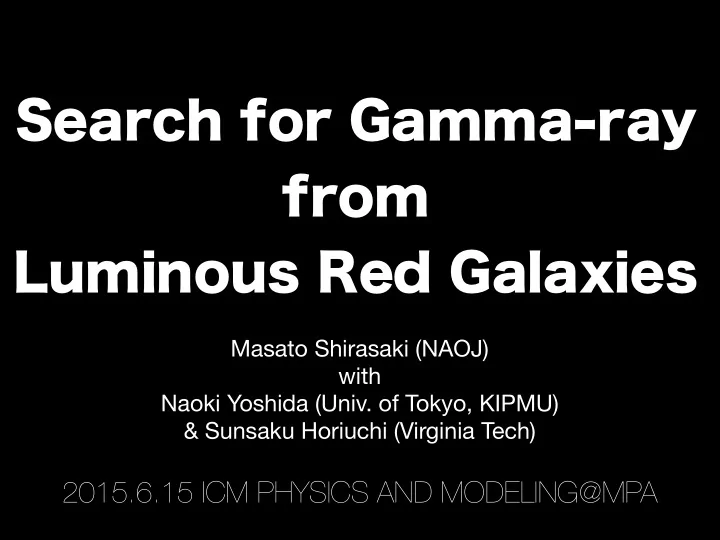

Search for Gamma-ray from Luminous Red Galaxies Masato Shirasaki (NAOJ) with Naoki Yoshida (Univ. of Tokyo, KIPMU) & Sunsaku Horiuchi (Virginia Tech) 2015.6.15 ICM PHYSICS AND MODELING@MPA
Recent progress on Gamma-ray studies The detection of angular correlation of the position of galaxies and gamma-ray maps! • Correlation between large-scale structure and gamma-rays would be a probe of dark matter (DM) annihilation • If DM would annihilate, the high density region in the Universe would be gamma-ray source. • The strength of correlation can relate to the production rate of gamma-rays in extragalactic DM halos, or annihilation rate of DM • Various tracers could be correlated with extragalactic gamma-rays Xia et al. (2015) • Unresolved blazars, star forming galaxies, radio galaxies
Toward the detection of DM annihilation • We should consider some optimized targets for indirect search for DM annihilation. • The conditions to be considered • they should live in high density regions in the Universe • they should be less a ff ected by astro sources • their statistical properties should be well constrained • it is desirable to know the relation to their host dark matter halos LRGs seem to be nice, let us examine the case of LRGs!
SDSS DR7 LRG • Kazin et al 2010, ApJ, 710, 1444 • Passive galaxies used for cosmological analyses (i.e. galaxy clustering & BAO measurement) • 30272 spectroscopic galaxies • exist 160 mock catalogs (LasDamas simulations) • typical halo mass ~ 10 13-14 M sun /h (derived from g-g lensing and clustering analysis) use blue one!
Survey region point sources • use 3rd year point source catalog • find 507 sources and use mask with radius of 2 deg • also remove |b|<20° and Loop-I/bubble regions • sky fraction of remaining regions ~ 0.052 (corresponding to ~2000 deg 2 ) Loop-I/bubble |b|<20°
Cross correlation • use 1-500 GeV gamma-ray intensity • P7rep ultraclean class • we have subtracted the galactic component • use 8944 LRGs (due to additional masking SDSS DR7 sky) • analysis performed in real space • the binning in linear spacing as θ i = 0.5 × i [deg] (i=1-40) • estimate covariances by using LasDamas Mocks and poisson photon catalog
Stacked image LRGs are here
Cross correlation signal measured signal is consistent with a null signal we passed the null test (i.e. correlation of mock LRGs and EGB) → Poisson sampling variance of LRG > photon poisson error
Modeling of correlation • HOD modeling based on Ando 2014 (arXiv:1407.8502) • HOD of LRGs has been studied • Redshift distribution of LRGs determined by spec-z • ( Almost the only ) remaining uncertainty = boost factor • model A : Gao et al (boost factor~300 for DM halo with mass of 10 13-14 M sun /h) • model B : Sanchez et al (boost factor~30 for DM halo with mass of 10 13-14 M sun /h) • PSF e ff ect is also taken into account
Likelihood Analysis 95% confidence level
Systematic error due to modeling of galactic components repeat the same analysis for di ff erent 32 galactic model templates typical uncertainty Δχ 2 ~ 1 stat. error ~ 10 times syst. error It would be important for Euclid!
Possible correlation by star forming in LRG • already detected the gamma-rays from nearby star forming galaxies • we examine how large correlations would cause if LRGs form stars with some rate • Let us consider the simplest Ackermann et al (2012) case: all the LRGs have the fix SFR same star forming rate (SFR) • Using the correlation of L γ and SFR, we can evaluate the gamma-ray flux of each LRG in known the distance estimate γ -ray our catalog of each LRG flux of each LRG
Possible correlation by star forming in LRG Gamma-rays due to star forming would have less a ff ect on our analysis even in the case of SFR = 10 M sun /yr
Summary • Cross correlation of SDSS DR7 LRGs and Fermi EGB • LRG is one of the best targets to search for DM annihilation • well-studied HOD/typical halo mass • passive star forming (less contaminated by astrophysical sources) • spec-z is available and they are relatively closer (z=0.1-0.4) • The main model uncertainty = boost factor only (except for dN/dE) • Our measurement is consistent with null detection • put constraints on DM annihilation for DM halos with mass of 10 13-14 M sun and redshift of z=0.1-0.4 • impact of model uncertainty of galactic gamma-ray • One of possible contaminants = Star forming in LRGs • gamma-rays by star forming phenomena would have a small influence on our correlation analysis
Check: EGB intensity
di ff erence between the models of < σ v>=3x10 -26 cm 3 /s boost factor M=100 GeV bb
Case of small mask 2deg mask (8944 samples) 1deg mask (17465 samples) The improvement is simply caused by the increase of number of LRGs
Recommend
More recommend